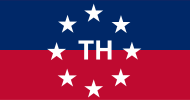Charles J. McCarthy
| Charles James McCarthy | |
|---|---|
.jpg) | |
| 5th Territorial Governor of Hawaii | |
|
In office April 18, 1918[1] – June 1, 1921[2] | |
| Appointed by | Woodrow Wilson |
| Preceded by | Lucius E. Pinkham |
| Succeeded by | Wallace R. Farrington |
| Member of the Senate of the Territory of Hawaiʻi[2] | |
|
In office 1907–1912 | |
| Member of the House of Nobles of the Kingdom of Hawaiʻi[1] | |
|
In office 1890–1890 | |
| Personal details | |
| Born |
August 4, 1861 Boston, Massachusetts |
| Died |
November 26, 1929 (aged 68) Honolulu, Territory of Hawaii |
| Spouse(s) | Margaret Theresa Morgan[2] |
| Military service | |
| Allegiance | Republic of Hawaii |
| Service/branch | National Guard of Hawaii |
| Years of service | 1888-1902 |
| Rank |
Captain (Rifles) Lieutenant Colonel (Guard) |
Charles James McCarthy (August 4, 1861 – November 26, 1929) was the fifth Territorial Governor of Hawaii and served from 1918 to 1921.[3]
McCarthy was born August 4, 1861 in Boston, Massachusetts, to Charles McCarthy and Joana (McCarthy) McCarthy.[4] McCarthy moved with his parents to San Francisco, California in 1866.[4] he was appointed by President of the United States Woodrow Wilson to the office after the term of Lucius E. Pinkham. Co-founder of the Hawai'i Democratic Party, McCarthy was a marginal entrepreneur who came to Hawaii to manage the affairs of a wholesale fruit house. McCarthy owned a saloon and for a time bottled his own alcoholic beverages. He was a member of the House of Nobles in 1890, supporter of Liliuokalani and ironically a captain in the pro-annexation Honolulu Rifles. He also was a territorial senator 1907-12 and treasurer 1912-14 before becoming chief executive. McCarthy believed Republicans were promoting immigration of Oriental laborers to manipulate Hawaii’s demographics to their advantage and served their own business interests, McCarthy was ardently anti-Asian. He appointed Charles Rice and Alfred Castle to lobby in favor of the Hawaiian Rehabilitation Bill which became the Hawaiian Homes Commission Act . The omnibus bill also contained language that made it difficult for “Orientals” from winning homesteads, and barred them from federal jobs in favor of Hawaiians. McCarthy also proposed that the military replace self-government in order to negate possible bloc voting by the large Japanese population in Hawaii. When asked by a congressman if the Japanese would think the action was directed at them, McCarthy said, “Let them think so; what do we care?” McCarthy also railed against the land policies of the Big Five and was the first governor to advocate statehood for Hawaii. Annoyed by the policies of his Democratic administration, McCarthy was gently nudged out of politics by Republicans. In return, he was given a job as Washington representative of the Honolulu Chamber of Commerce, and later general manager of Hawaiian Dredging Co. during which he worked on the Waikiki Reclamation project which resulted in the construction of the Ala Wai Canal. He died in 1929 in Honolulu, Hawaii.
References
| Wikimedia Commons has media related to Charles J. McCarthy. |
- 1 2 Charles J., C. J. (1921), The Journal of the American-Irish Historical Society, Volume XIX, New York, NY: American-Irish Historical Society, p. 192.
- 1 2 3 Charles J., C. J. (1921), The Journal of the American-Irish Historical Society, Volume XIX, New York, NY: American-Irish Historical Society, p. 194.
- ↑ "Charles J. McCarthy - Hawaii History - Governors". Info Grafik Inc. Retrieved 2007-08-11.
- 1 2 Charles J., C. J. (1921), The Journal of the American-Irish Historical Society, Volume XIX, New York, NY: American-Irish Historical Society, p. 193.
- The Journal of the American-Irish Historical Society, Volume XIX (1921).
| Political offices | ||
|---|---|---|
| Preceded by Lucius E. Pinkham |
Territorial Governor of Hawaii April 18, 1918 - June 1, 1921 |
Succeeded by Wallace R. Farrington |

